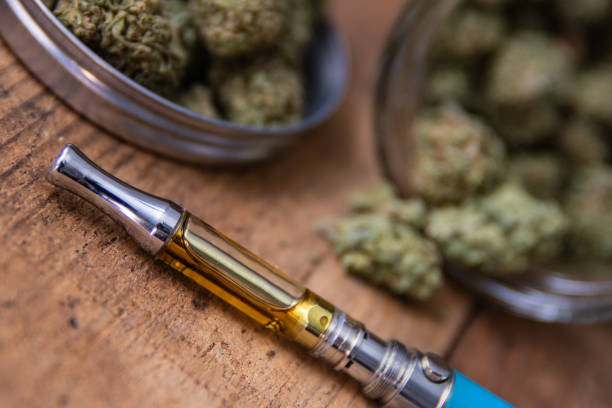
Everything You Need to Know About Dry Herb Vaporizers
Have you ever noticed that, despite how much you enjoy smoking marijuana, you're starting to feel less enthusiastic about it because of its negative side effects? Smoking marijuana isn't the healthiest way to consume it, as it can cause problems with breathing, a hoarse throat, and other things. Perhaps it's the primary driver for the emergence of more recent cannabis consumption methods. We recognise that not all of us will desire to use tinctures, edibles, cannabis oil, or other oral ways every time we want to get high to stop smoking. However, they aren't the only choices accessible. Vaporizers for dried herbs can help in this situation.
One of the trendiest options for folks looking for novel and distinctive ways to consume cannabis is a dry herb vaporizer. Prefills and pre-rolls are easier to find and more practical. However, a dry herb vaporizer is distinct since it uses real dry cannabis instead of concentrate or oil. Additionally, pot vaporizers use considerably more sophisticated technology than pre-filled carts. Users also have better control over their vaping experience because of it.
LEARN MORE ABOUT DRY HERB VAPORIZERS AND THE COMBUSTION PROCESS
Vaporizers raise the heat just enough to evaporate the cannabinoids and terpenes in cannabis, enabling us to inhale vapour containing these substances instead of smoke, as opposed to smoking, which requires the combustion process to absorb the marijuana. The combustion mechanism is the primary distinction between vaporizers and smoking.
Secondhand substances are discharged into the smoke during combustion, including 80% non-cannabinoids and half a dozen identified PAHs that are also present in tobacco use. Only 5% of the vapour is inhaled, while vaping contains non-cannabinoids since these temperatures are not reached during vaping.
You're not required to stick to one of these camps, though. The best of both worlds is available with hybrid vaporizers, which function just as well with dry herbs and concentrates—even simultaneously!
WHAT MAKES IT BETTER THAN SMOKING?
Marijuana vaporizers are exceptional because of their cutting-edge technology. Other nicotine e-liquid vaping devices are likewise quite sophisticated but have limitations. Other material vapes don't have capabilities like Bluetooth connectivity or downloading apps to access more adjustable functions, which marijuana vaporizers have.
Dry herb vaporizers have much more technology built into them than other vaping equipment. They could also be substantial desktop vaporizers with internal fans and heat exchangers to produce vapour at a more sophisticated level, depending on the brand, model, and kind. That type of technology is not available for other materials.
HOW DOES IT WORK?

Convection and conduction are two different ways that dry herb vapes can work. Both involve heating the buds to release the terpenes and cannabinoids, also known as the decarboxylation process, into vapour.
For one aspect of conduction, heat is transferred to your buds through direct contact with the herbs using heating devices. The best way to describe it is to picture your ears being warmed by a heating pad as if you were heating food in a skillet on the stove.
Conversely, convection would heat your buds by generating a warm, or rather hot, confined temperature around your buds, somewhat like baking a cake. It would work more like an oven in your kitchen. In this manner, the herbs are cooked gradually and uniformly without burning. Some dry herb vaporizers employ just one of the two techniques, while others combine the two. There aren't any significant distinctions between the two; test them both to see which one fits better for you.
Conduction vs. Convection
Please pay attention to the heating method because it has benefits and drawbacks and creates various vapor forms. The primary design of portable vaporizers is conduction. Conduction heating elements are less bulky, require less maintenance, and have fewer moving parts.
Users do not have to wait as long for vapour production because of the quick heating of conduction heating elements. The vapor clouds become larger, more intense, and smoke-like.
Conduction vaporizers also have the advantage of being less expensive than convection vaporizers.
Convection is more frequent in desktop units since it creates vapour by blowing hot air through herbs. Hot-air vaporizers are slightly more expensive than direct contact dry herb vaporizers, but they also require more time to heat up and have more complicated mechanisms.
WHAT ARE THE PARTS OF A DRY HERB VAPORISER?
Understanding the components of the vaporizer would be the greatest first step to acquiring a thorough insight into dry herb vaporizers and determining whether they may fit your marijuana consumption lifestyle. Vaporizers, in summary, are made up of three components: chamber, mouthpiece, and battery.
Chamber
The chamber is where you set the herbs, even though it sounds like something from Game of Thrones or The Lord of the Rings. The first vapes to be sold would have chambers made of stainless steel. Modern vapes now have ceramic chambers, which retain heat better, heat up faster, and don't significantly alter the flavour of your marijuana.
Quartz is another frequent chamber material that requires more time to heat but retains the organic flavour of your marijuana more effectively than the first two.
Mouthpiece
The mouthpiece merely serves as the point at which you extract vapour from the chamber and place it in your mouth; there isn't much science involved. However, there is a wide range of mouthpiece materials and forms, so be sure to examine a few of them to see which one suits you the best. The most pleasant mouthpieces are typically thin or spherical, although their length may make it more difficult to inhale. On the other hand, flat mouthpieces avoid this issue, but they are typically more unpleasant. Vapes with glass mouthpieces provide superior flavour to those with silicone or hard rubber bits.
Battery
Your vape's battery can make or break the transaction. Avoid cutting corners on this aspect to avoid unpleasant surprises.
Most contemporary vaporizers use rechargeable lithium-ion batteries, which have a higher energy density and a slower discharge rate than Ni-Cad or NiMH batteries. Finally, depending on the model, you may or may not be capable of removing the batteries.
Remember that you'll occasionally need to recharge it, or if it becomes drained, you'll need to find other intake methods.
HOW TO USE A DRY HERB VAPORIZER
While some dry herb vaporizers may differ somewhat in their operation, most of them are rather straightforward to operate. Use your dry herb vaporiser as directed below:
#1 Read the Manual
We understand that when you have a brand-new piece of technology in your possession, you don't want to read any manuals; all you want to do is start using it.
However, manuals contain helpful instructions and tips on how to get the most out of your new gadget, so it would be a good idea to quickly read the handbook of your vaporiser before using it. Your vaporizer's instructions will undoubtedly find recommendations for ideal temperature settings and other fascinating usage modes.
#2 Recharging
Whether you've read the documentation for your vaporiser, you'll undoubtedly discover that you must fully charge it before trying it. Nowadays, the majority of vaporizers currently on the market have USB chargers. Connect your dry herb vaporiser to a wall adaptor instead of a computer to charge it more quickly. Like other technological devices, strive to constantly charge your device to its maximum capacity and wait until it is discharged before recharging to prolong its battery life.
Doing this will aid the vape in calibrating the battery and extending its life.
#3 Burn-Off
This step, which you should complete before using your new vaporiser for the first time, won't likely be included in the instructions with your vaporiser. Once fully charged, ensure the chamber is empty and free of visible debris. The vape should be turned on and heated to the maximum setting. You must add 2-3 times to this process. By carrying out this burn-off procedure, you may be sure that any manufacturing or storage residues that might have remained in the chamber have been removed.
#4 Grinding the Weed
Before utilising your dry herb vaporiser, it's crucial to crush your marijuana buds. Large pieces of marijuana will probably not burn equally, leaving some areas more toasted than others.
You'll get better hits if you grind your cannabis to a medium-fine fineness so that it can pass past the mouthpiece of your vape and into your lungs.
#5 Packing the Chamber
Recall how we advised you to read the instruction manual. The step that reveals why is this one. You'll want to understand how you should stuff your chamber since not every vaporiser is the same.
Add some fairy dust, also known as kief or pollen, as you pack your chamber for a little additional magic.
The trick is never to pack your dry herb vape too tightly; otherwise, the device can become inoperable.
#6 Preheating
Most dry herb vaporizers on the market now have a preheating feature. Use it to reach the desired temperature and enhance your vaping experience quickly.
#7 Setting the Temperature
The next step is choosing your temperature after preheating your vaporiser.
Some vaporizers include temperature presets, while others let you dial a specific temperature. In either case, it can take you a few tries to discover the temperature setting that is most comfortable for you. Cannabis is often vaped at a temp of 170 to 220 °C.
#8 Enjoy!
After completing the previous procedures, you're ready to use your dry herb vaporiser to take a puff. Remember that using a vaporiser is not the same as using a bong or a joint; you need to take slow, regular draws that last at least three to five seconds.
Additionally, keep in mind that using it may cause more cannabis and terpenes to be released. That's why it's best to take a few puffs and wait a few minutes before checking the intensity of the high to avoid getting overly stoned, if such a thing even exists, too quickly.
FREQUENTLY ASKED QUESTIONS
Why should I use a dry herb vaporiser?
Burning anything produces dangerous byproducts, and burning marijuana is no different. Users who choose to vape marijuana rather than smoke it can experience the same high with fewer pollutants and chemicals.
Do vaporizers for dry herbs harm the lungs?
It would be best if you did not breathe anything besides oxygen into your body—the same holds for herb vaporiser vapour. Not being smoked may harm the lungs and airways if inhaled frequently.
Are they safe for COVID?
Vaporizers do not work well with COVID. However, when it comes to the harm you can do to your lungs, there isn't much difference between using a vaporiser and smoking. Stopping smoking or vaping would be wise if you are concerned about contracting Covid to avoid any unfavourable results.
Do they set off smoke alarms?
Since it cannot tell the difference between smoke and aerosol, it will activate if it detects vapour. However, not all smoke alarms are created equal, so some might miss the compounds in the aerosol. Some smoke alarms feature specialised detecting particles and are extremely sensitive.
DRY HERB VAPORISERS
Using a dry herb vaporizer is the best way to consume marijuana and get the most out of its advantages while avoiding its drawbacks. Additionally, since a dry herb vaporiser doesn't require concentrates, you won't have to take the added step of creating or purchasing them.
Check out our collection of dry herb vaporisers and more here at Vaporisers Australia!


